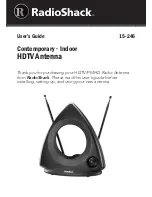
6012-12W Installation Manual
Site Survey
2.5.1.
Vertical Masts
Vertical masts are a very ancient and common mast design. In essence, it is the mast derived from
the sailing mast and adapted for mounting the ever-increasing array of antennae which ships need to
communicate with the world. This drawing of a
vertical mast shows the preferred mounting of the
ADE center-line above the plane of the radar.
Alternatively the ADE is mounted below the plane of the radar signal
Vertical masts are most commonly found on
cargo ships – they are simple, inelegant and
functional. They are also fairly stiff against
torsional reaction and lateral vibrations, as long as the ADE is mounted on a stiff pedestal near the
vertical centerline of the mast. If centerline mounting is impractical or otherwise prohibited, the
mast platform the ADE is mounted on should be checked for torsional vibration about the centerline
of the mast and the orthogonal centerline of the platform.
If the estimated natural frequency of the mast or platform is less than 35 Hertz, the mast or platform
should be stiffened by the addition of deeper gussets under the platform or behind the mast.
2.5.2.
Raked Masts
Raked masts are found on vessels where the style or appearance of the entire vessel is
important. Again, the inclined mast is a direct descendant
from the masts of sailing ships – as ship owners
wanted their vessels to look more unique and
less utilitarian, they ‘raked’ the masts aft to
make the vessel appear capable of speed. This
drawing shows a raked mast, again with the
preferred ADE mounting above the radar and
alternate with the ADE below the radar.
Raked masts pose special problems in both
evaluating the mast for stiffness and mounting of antennae. As can be seen in the drawing, all
antennae must be mounted on platforms or
other horizontal structures in order to maintain
the vertical orientation of the antenna centerline. This implies a secondary member which has a
different natural frequency than the raked mast’s natural frequency. In order to reduce the mass of
these platforms, they tend to be less stiff than the main box structure of the raked mast. Thus, they
will have lower natural frequencies than the raked mast itself. Unfortunately, the vibratory forces
will act through the stiff structure of the raked mast and excite these lighter platforms, to the
detriment of the antenna.
2.5.3.
Girder Masts
Girder masts are large platforms atop a pair of columns. Just like girder constructions in buildings,
they are relatively stiff athwart ship – in their
primary axis – but less stiff longitudinally and
torsionally. An example of a girder mast is shown in this drawing, with the preferred ADE mounting
outboard and above the radar directly on one of the
columns and alternate with the ADE centered on
the girder above the plane of the radar.
The greatest weakness of girder masts is in torsion
–
where the girder beam twists about its vertical
centerline axis. As with all mast designs discussed so far, mounting the antenna in line with the
vertical support structure will reduce the vibration tendencies. Mounting the antenna directly above
2-4
EAR Controlled - ECCN EAR99
Summary of Contents for 6012-12w
Page 101: ......
Page 102: ......
Page 103: ......
Page 106: ...8 7 6 5 4 D 5 C B A 8 7 6 5 4 ...
Page 116: ...8 7 6 5 4 3 50 58 58 59 2X 1 52 58 58 59 2X ...
Page 120: ......
Page 128: ......
Page 129: ......
Page 130: ......
















































